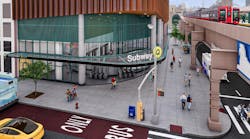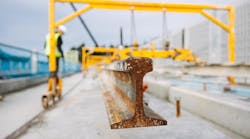New York Metropolitan Transportation Authority (MTA) Chairman Janno Lieber's recent announcement that the agency will study extending a future subway line even further along Manhattan West 125th St. is fraught with problems. MTA Capital Construction President Jamie Torres-Springer said "the potential expansion of Second Avenue subway not to the south but west along 125th St.“
Imagine the cost of creating a 125th St. crosstown line, which could add between two and four more subway stations depending upon which potential alternative is selected. This new phase for Second Avenue subway could either:
- Terminate at Broadway and 125th St.
- Turn north below Broadway and offer a transfer connecting with the 1 train at 137th St. (Alphabet designed subway lines run equipment that is too wide to run on Numbered lines)
- Continue uptown below Riverside Drive up to 137th St.
- Advance north under St. Nicholas Avenue to connect the with the B and C subway lines at 135th St.
The extension across 125th St. between the current Second Avenue Q line would provide upper Manhattan connections to the #1, A, B, C and D subway lines. It would connect Manhattan uptown neighborhoods with those in the upper East Side. The price tag for this new phase could be between $5 billion to $10 billion depending upon which option is selected.
Many years would be needed to either add this scope of work to Second Avenue Subway Phase Two or as a stand alone new Third Phase. There would be the need for completion of the National Environmental Policy Act (NEPA) process leading to a positive Record of Decision (ROD) from the Federal Transit Administration (FTA).
Next is final design and engineering, completion of all business relocation, real estate acquisition and private property easement rights. Agreements with New York City and various owners of underground utilities, including water, sewer, gas, electric, steam and cable, would also need to be finalized before being ready to commence construction. This new phase would also need to be admitted into the FTA's Capital Investment Grants (CIG) New Starts Core Capacity program. The MTA would also have to find billions in the future 2025 - 2029 and 2030 - 2034 Five Year Capital Programs to provide the required local share for any FTA Full Funding Grant Agreement (FFGA).
The MTA would also re-designate and postpone the future $13 billion Second Avenue Third Phase (72nd Street to Houston Street) and $13 billion Fourth Phase (Houston Street to Hanover Square) to become Phases Four and Five. Funding would probably not be available for these phases until the 2040 - 2044 Five Year Capital Plan and next 2045 - 2064 Twenty Year Capital Needs Plan for future funding.
MTA clearly lacks both funding and technical capacity to advance any combination of two new phases for the Second Avenue Subway within the same time frame.
Second Avenue Subway Phase 2 has grown from $5.5 billion to $7.7 billion. In April 2019, Lieber claimed the MTA could save between $500 million to a $1 billion in costs for the proposed Second Avenue Subway Phase 2. This would have reduced the overall tab at that time down to $5 billion. Promised cost savings were based upon reduction in excavation for the 125th Street Station and building the 116th Street Station in space no longer needed for other project work. In February 2022, the MTA came clean and admitted the cost increased to $6.9 billion. Once again, in 2023 according to the 2025 - 2044 Twenty Year Capital Needs Plan, the MTA estimated cost grew to $7.5 billion.
The MTA has a history of low balling project costs by hiding both financing and debt service payments under the agency operating rather than capital budget. They also frequently program insufficient contingency funding. These funds are needed to cover costs when contractor bids come in higher than the engineer's cost estimate. They also pay for contract change orders during the course of construction due to unforeseen site conditions or scope changes requested by various maintenance, operations and other user groups.
Better to trust the March 2023 FTA Annual Report on Funding Recommendations for Federal Fiscal Year 2024 estimate of a $7.69 billion cost for Second Avenue Subway Phase 2. Even this number may grow over time. Trust the federal $7.7 billion price tag versus the MTA $7.5 billion.
One possibility is for the MTA to consider delaying initiation of $7.69 Second Avenue Phase Two until the 2030 - 2034 Five Year Capital Plan. This could provide sufficient time to accommodate one of the new four 125th St. cross town options. Any of these could add $5 to $10 billion more to the current forecasted Second Avenue Phase 2 project. Each new station could cost $500 million to a $1 billion. Tunneling each additional block could range between $100 to $250 million. Combining Phase 2 with advancing cross town along 125th Street could offer some savings by using the same tunnel boring machine contractor. Ditto for station construction, signal, power and track installation contractors. There will also be the need to purchase additional subway cars to maintain rush hour headway between trains.
New York Gov. Kathy Hochul and Lieber's believe that advancement of the $7.7 billion Second Avenue Subway Phase 2 project is inevitable. This reminds me of Rod Tidwell in the 1996 movie "Jerry Maguire" who said, "Show me the money."
Any FTA $3.4 billion funding as part of the $7.7 billion future CIG FFGA isn't real until the offer is made. MTA must accept the terms and conditions within the grant offer. This is still many months to a year or more away. FTA caps its funding at $3.4 billion. MTA becomes legally responsible for any cost overruns above and beyond the agreed upon project cost. The FTA will not increase its share.







